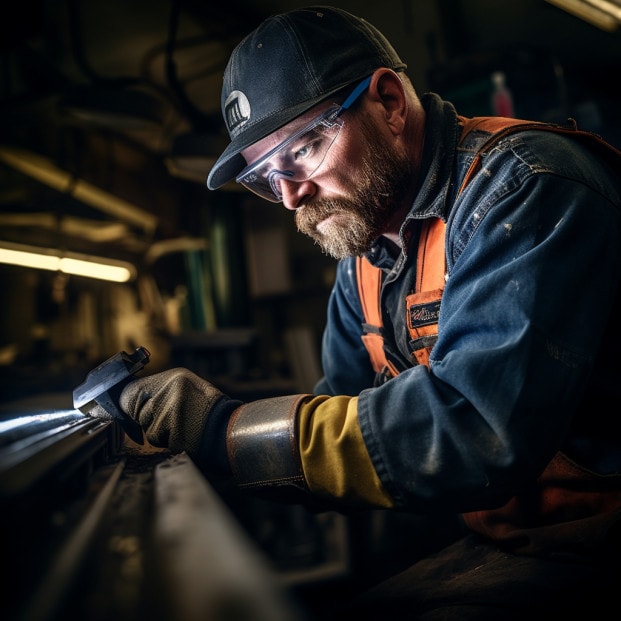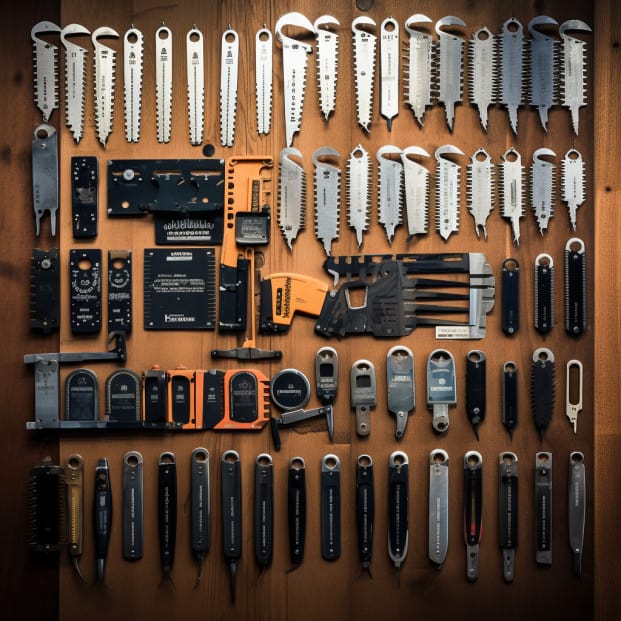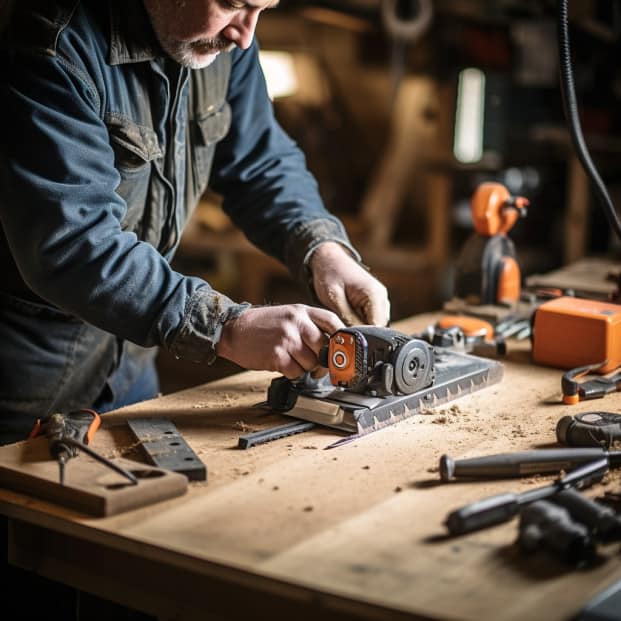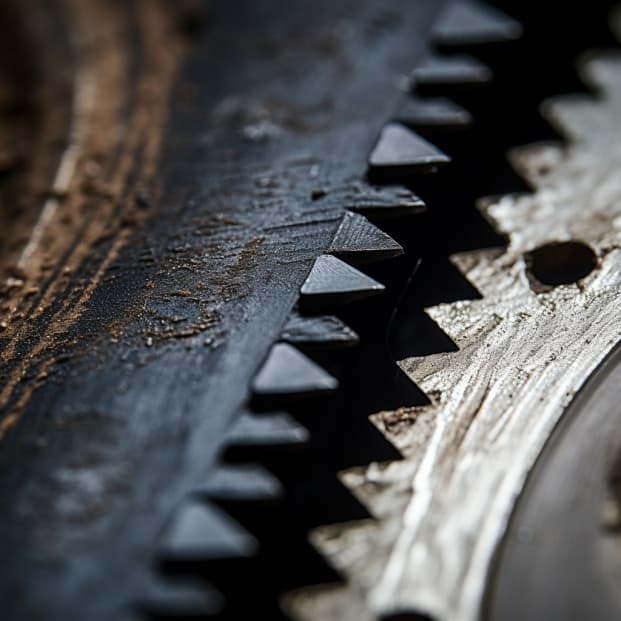Wondering how long those reciprocating saw blades really last?
As a professional contractor who’s been using these saws for over a decade, I can tell you there’s no one-size-fits-all answer.
The lifespan depends on several factors – from blade type to materials cut.
In this quick guide, I’ll share insider tips on getting the maximum lifespan from your blades based on my own experience.
Whether you’re a DIYer or a pro, you’ll learn my top tricks to extend blade life so you get the most bang for your buck.
Let’s dive in!
KEY TAKEAWAY
How long do reciprocating saw blades last?
Reciprocating saw (1) blade lifespan varies based on usage and maintenance, typically lasting several hours of continuous cutting.
Regular maintenance and careful usage can extend their durability.
Extending the Lifespan of Reciprocating Saw Blades
Getting the most out of your reciprocating saw blades means taking steps to maximize longevity.
Based on years of use, here are my top tips:
- Use the right blade for the material. Metal, wood, and masonry each need their own blade type. Matching the blade prevents premature wear.
- Check teeth before use. Inspect for damage or dullness. Nicked, bent, or dull teeth wear faster under use. Replace questionable blades.
- Let the blade do the work. Don’t force blades through material. Apply steady pressure and allow the teeth to cut efficiently. Forcing causes cracks.
- Avoid heating blades. Take breaks to let hot blades cool if making lengthy cuts. Heat weakens blade metal over time.
- Store blades properly. Keep blades somewhere clean and dry to prevent corrosion. Individual cases help prevent damage.
- Sharpen blades occasionally. Use a specialty sharpening stone to refresh edges and teeth. Don’t over-sharpen – some loss of material is inevitable.
Following proper practices tailored to reciprocating saws helps maintain blade integrity and significantly extends useful life. Treat blades well for less replacement!
Lubrication and Maintenance: Key to Blade Longevity
Proper lubrication and maintenance makes a big difference in reciprocating saw blade lifespan. Here’s how to care for blades:
- Lubricate blades. Use blade lubricants designed for reciprocating saws. This reduces heat and friction that can damage teeth.
- Clean after use. Remove debris, sap, and grit that adheres to blades. Solvents or soapy water work well.
- Inspect routinely. Check blades for cracks, missing teeth, and warping. Damaged blades need replacement.
- Avoid moisture. Store blades in a dry place to prevent corrosion. Individual cases help protect them.
- Sharpen when dull. Use a specialty sharpening stone to refresh dull blades. Take care not to over-sharpen.
- Replace when worn. Retire blades once teeth are extremely worn or the blade is warped or cracked. Attempting to sharpen extensively shortened lifespan.
With the right care and maintenance, quality reciprocating saw blades can last through many jobs.
But neglecting lubrication and routine care cuts lifespan considerably.
A well-maintained blade serves you well!
Prices pulled from the Amazon Product Advertising API on:
Product prices and availability are accurate as of the date/time indicated and are subject to change. Any price and availability information displayed on [relevant Amazon Site(s), as applicable] at the time of purchase will apply to the purchase of this product.
Choosing the Right Reciprocating Saw Blades

Selecting the best reciprocating saw blade for the job ensures optimal cutting performance. Here are tips on choosing blades (2):
- Consider the material. Metal, wood, masonry each need specific blades. Matching prevents premature wear.
- Factor in material thickness. Thicker materials require more teeth for slower feed rate. High TPI blades bind up.
- Assess blade coatings. Coatings like titanium or Teflon improve wear resistance for metal or abrasive cuts.
- Mind blade length. Longer blades are better for thick stock. Shorter blades offer more control on tighter cuts.
- Pick blade styles carefully. Shapes like flush cut and curved blades suit specialty cuts not possible with straight.
- Understand tooth styles. Some teeth are optimized for ripping versus cross cuts or soft versus hard woods.
Choosing the right blade style, length, tooth configuration, and coating based on your material and cut will maximize cutting performance and blade longevity.
The Durability of Various Blade Materials
Reciprocating saw blade materials vary in their durability and longevity. Here’s how they compare:
- High carbon steel offers good strength and edge-holding for wood and light metals. Prone to bending.
- Bi-metal blades combine hard high-speed steel teeth with flexible spring steel cores making them very durable for heavy usage.
- Carbide-tipped blades last the longest, retaining sharp cutting edges even on hard materials like stainless steel or concrete. Most expensive option.
- Diamond grit blades have small industrial diamond particles embedded in the steel for abrasive cutting. Excel at masonry work but cost more.
- Ceramic coated blades resist high heat when cutting metals. The ceramic helps dissipate heat to protect blade.
- Coated steel blades utilize coatings like titanium or Teflon to reduce friction. Enhances wear resistance.
Selecting blades made with, or incorporating, harder and more heat/abrasion-resistant materials ensures the longest-lasting cutting performance from your reciprocating saw.
Precision Cuts with Top Reciprocating Saw Blades
Achieving clean, accurate cuts with a reciprocating saw relies on using the right blade. Here are my blade recommendations:
- Metal cutting – For precise cuts in sheet metal and thinner stock, carbide grit or bi-metal blades with 8+ TPI minimize roughness.
- Detail woodwork – High TPI count blades like 12-14 TPI produce super smooth cuts in wood Projects like furniture or trimwork.
- Curve cutting – Flush cut or curved blades allow following a line for precision versus standard straight blades.
- Fast cross-cutting – Lower TPI blades around 6 TPI aggressively rip through wood quickly but leave a rougher cut than higher TPI.
- Pruning – Specialty pruning blades efficiently cut branches at wide angles without binding.
Top brands like Diablo, Milwaukee, Bosch, DeWalt, and Makita offer high-end blades engineered for precision cuts. With the right selection, these saws can rival a bandsaw!
Prices pulled from the Amazon Product Advertising API on:
Product prices and availability are accurate as of the date/time indicated and are subject to change. Any price and availability information displayed on [relevant Amazon Site(s), as applicable] at the time of purchase will apply to the purchase of this product.
Prices pulled from the Amazon Product Advertising API on:
Product prices and availability are accurate as of the date/time indicated and are subject to change. Any price and availability information displayed on [relevant Amazon Site(s), as applicable] at the time of purchase will apply to the purchase of this product.
Prices pulled from the Amazon Product Advertising API on:
Product prices and availability are accurate as of the date/time indicated and are subject to change. Any price and availability information displayed on [relevant Amazon Site(s), as applicable] at the time of purchase will apply to the purchase of this product.
The Science Behind Blade Lifespan

The lifespan of reciprocating saw blades comes down to basic materials science. Here are key factors:
- Hardness – Harder metals like carbide and tool steel better resist wearing down from cutting friction. They maintain sharp edges longer.
- Toughness – Materials balance hardness with flexibility to resist impact stresses that cause chipping, cracks, and blade failure.
- Heat resistance – Lower conductive metals dissipate heat during cutting to avoid losing temper from excessive temperatures weakening the blade.
- Corrosion resistance – Metals like stainless steel better resist environmental moisture and acids that lead to rust and deterioration over time in storage.
- Coatings – Ceramic and Teflon-style coatings further combat wear, friction, corrosion and heat for extended blade life.
Understanding the science behind blade materials allows selecting optimized blades and caring for them properly to maximize lifespan. Choose wisely!
Blade Lifespan and the Importance of Durability
The lifespan of a reciprocating saw blade comes down largely to its durability. Blades made of longer-lasting materials can withstand far more cutting before needing replacement. Here’s why durability matters:
- Performance over time – Durable blades maintain sharp cutting edges even after significant use, while lower quality blades quickly go dull. You get superior cuts for longer.
- Materials versatility – The most durable blades can transition between wood, metal, masonry without radically shortening life. Specialty blades wear out faster.
- Cost savings – Blades with enhanced durability withstand far more wear before retirement. You don’t have to replace them nearly as often, saving money.
- Safety – A worn out, damaged blade is prone to cracking, slipping and binding which can cause the saw to kickback dangerously. Durable blades stay intact.
- Reliability – You can count on a heavy duty blade to get the job done. Weaker blades risk breaking mid-cut and ruining the workpiece.
For demanding cutting tasks, investing in the highest durability reciprocating saw blades pays off via longevity, versatility, safety and reliability.
Take time to choose the right blade, and it will work hard for you.
When shopping for reciprocating saw blades, durability should be one of the top considerations along with blade type, tooth configuration and coatings.
Do your research to determine which blades deliver the kind of long-lasting stamina required for your projects.
Quality materials make a big difference.
More on Reciprocating Saw Blades

Frequently Asked Questions
How long will a typical reciprocating saw blade last?
A typical reciprocating saw blade will last 20 to 30 hours of use depending on the material being cut.
Lighter duty applications like cutting wood may get 30 hours while heavier duty tasks like cutting metal with a metal reciprocating saw blade may only get 20 hours.
Proper blade care and not forcing the blade to cut can help extend the life.
Why do reciprocating saw blades dull so quickly?
Reciprocating saw blades are designed for fast cutting in tough materials which causes accelerated wear of the teeth.
The high speed reciprocating action and impact forces mean the small cutting edge undergoes a lot of stress.
This is why metal blades or pruning blades made with harder materials like tungsten carbide or high speed steel will last longer than regular steel blades.
What types of reciprocating saw blades are available?
There are blade types for different materials like wood, metal, plastic and masonry.
Within these categories there is variation in features like teeth per inch (TPI), material construction and thickness.
Common blade materials are high carbon steel, carbide grit, diamond grit and tungsten carbide.
Blades also differ in intended uses from general purpose to more specialized tasks like pruning, metal cutting or removing nail embedded wood.
How do I know which blades to use for different materials?
As a general rule, use finer tooth (higher TPI) blades for lighter materials like wood or plastic, and coarser tooth (lower TPI) blades for denser materials like metal or concrete.
Refer to the blade packaging or manual for material being cut recommendations.
You may need different blade types like a wood blade versus a metal reciprocating saw blade.
Avoid forcing a blade to cut if it’s not rated for the material.
What factors influence how long a blade will last?
Key factors include the material being cut, thickness of the material, blade type/material, and your technique.
Blades cutting thicker denser materials will dull faster than thinner lighter materials.
Blades made with harder materials like tungsten carbide or carbide grit will last longer than regular steel blades.
Applying too much pressure or dragging the blade through the cut can cause premature wear.
Proper technique extends blade life.
What is the ideal tooth count for different materials?
For softwoods most reciprocating saws work well with 6-8 teeth per inch (TPI).
Hardwood and laminates do well with 10-12 TPI blades.
For plastics, fiber cement and non-ferrous metals look for 14-18 TPI reciprocating saw blades.
Cast iron and stainless steel are better cut with coarse grit or carbide tipped blades with 4-6 TPI.
Always refer to the blade packaging for recommended materials and TPI.
Conclusion
Before you cut…
Now you’ve got insider knowledge to maximize the lifespan of your reciprocating saw blades.
But there’s more to learn to master these versatile tools! In my next guide, I’ll share pro tips for effortless cutting and avoiding blade failures.
Stay Tuned: 5 Pro Tricks for Reciprocating Saw Success
You May Like These:
How to Choose the Right Blade for Any Cutting Job
Safely Using a Reciprocating Saw for DIY Projects
When to Replace Your Reciprocating Saw Blade
References
- https://en.wikipedia.org/wiki/Reciprocating_saw
- https://www.lowes.com/n/buying-guide/choose-best-reciprocating-saw-blade
Related Articles
- https://allthingsgardener.com/are-reciprocating-saw-blades-universal/
- https://allthingsgardener.com/reciprocating-saw/
- https://allthingsgardener.com/is-a-wood-chipper-worth-it/






